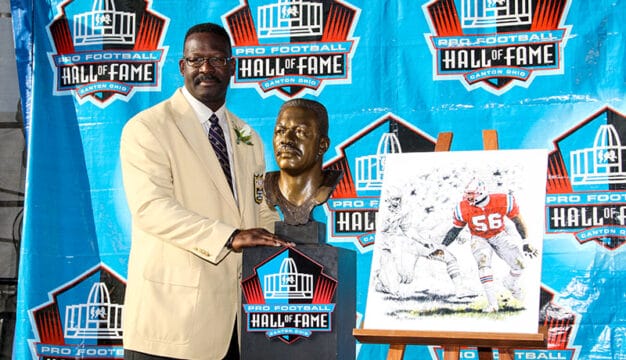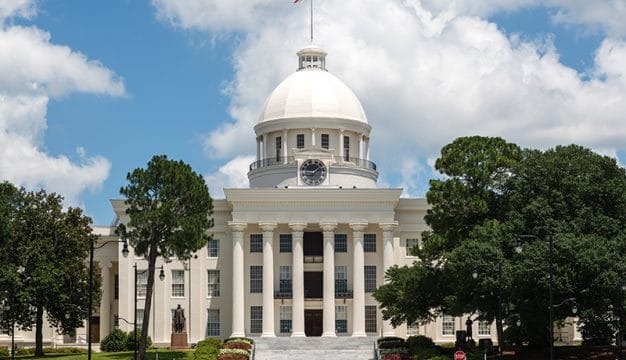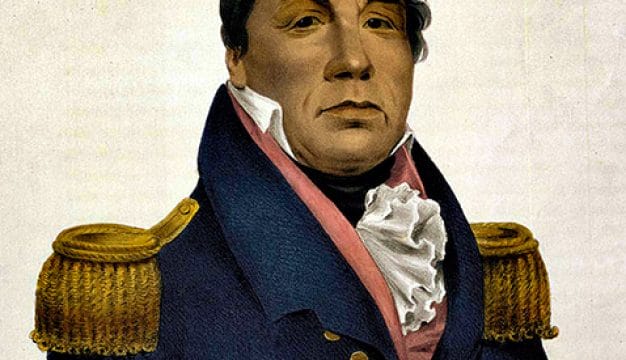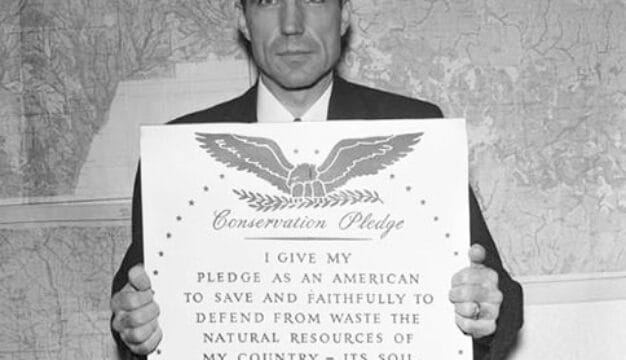USS Alabama (BB-60)
The USS Alabama (BB-60) is a World War II-era battleship and the fifth ship named after the state of Alabama. It first served in the Atlantic theater of operations during the war but was better known for its role in helping to take Japanese-held islands in the Pacific from 1943 to 1945, earning numerous citations. It is now the centerpiece of USS Alabama Battleship Memorial Park on the Mobile River, in Mobile, Mobile County, and one of the state’s most visited attractions.
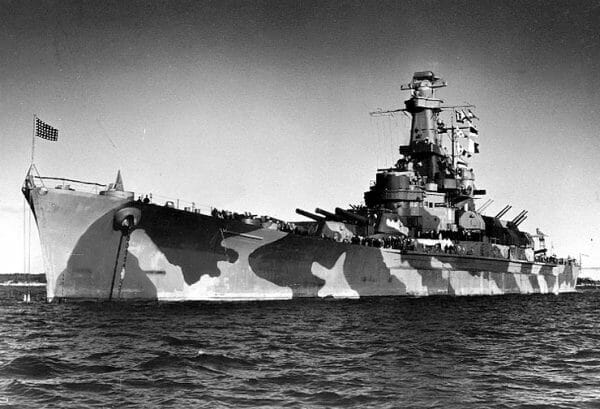 USS Alabama (BB-60)
Construction began on February 1, 1940, at the Norfolk Navy Yard in Portsmouth, Virginia. More than 3,000 men and women, working 24 hours a day for 30 months, brought the $80 million project to completion nine months ahead of schedule. The largest ship ever built in Portsmouth, it displaces 35,000 tons. When laden for action, it weighed 45,000 tons, or 90 million pounds. The ship measures 680 feet long, 108 feet and 2 inches abeam (meaning at the widest point), and rises 194 feet from keel to top light. Despite its bulky size, the Alabama‘s advanced design enabled it to steam at 28 knots, or almost 32 miles per hour. The vessel was christened on February 16, 1942, by Henrietta Hill, wife of Alabama senator Lister Hill. Commissioned on Sunday, August 16, 1942, the Alabama underwent sea trials in the Chesapeake Bay under the command of Capt. George B. Wilson and was known by her 2,500-man crew as the “Mighty A.”
USS Alabama (BB-60)
Construction began on February 1, 1940, at the Norfolk Navy Yard in Portsmouth, Virginia. More than 3,000 men and women, working 24 hours a day for 30 months, brought the $80 million project to completion nine months ahead of schedule. The largest ship ever built in Portsmouth, it displaces 35,000 tons. When laden for action, it weighed 45,000 tons, or 90 million pounds. The ship measures 680 feet long, 108 feet and 2 inches abeam (meaning at the widest point), and rises 194 feet from keel to top light. Despite its bulky size, the Alabama‘s advanced design enabled it to steam at 28 knots, or almost 32 miles per hour. The vessel was christened on February 16, 1942, by Henrietta Hill, wife of Alabama senator Lister Hill. Commissioned on Sunday, August 16, 1942, the Alabama underwent sea trials in the Chesapeake Bay under the command of Capt. George B. Wilson and was known by her 2,500-man crew as the “Mighty A.”
A member of the South Dakota Class of battleships, the Alabama was designed specifically for providing shore bombardment and anti-aircraft defense for aircraft carriers. The ship carries a total of 129 guns; its profile is dominated by three large main turrets with armor 18 inches thick, each carrying three 16-inch 45-caliber guns that could propel a 2,700-pound projectile more than 20 miles with great accuracy. In addition, the ship also bears 10 smaller side turrets that each carry two 5-inch 38 caliber guns and 12 installations of four Bofors 40-mm, and originally was fitted with 52 20-mm Oerlikon cannons, which complemented the anti-aircraft battery during close encounters.
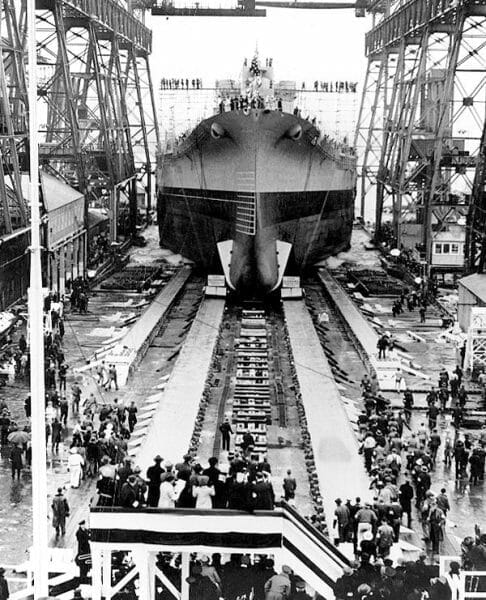 Launching of the USS Alabama
After a training period off the Maine coast, the Alabama reported for active duty in early 1943 under Capt. Fred D. Kirkland, joining the British Home Fleet in the North Atlantic. Dealing with ice, snow, and severe weather, it protected British and Russian convoys on the famed Murmansk Run that delivered military supplies to the Soviet Union. Allied leaders also hoped the prize battleship would draw out the German dreadnought Tirpitz, but that battle never materialized. The Alabama is the only American ship ever honored by the former Soviet Union for its role in protecting the Russian fleet during World War II.
Launching of the USS Alabama
After a training period off the Maine coast, the Alabama reported for active duty in early 1943 under Capt. Fred D. Kirkland, joining the British Home Fleet in the North Atlantic. Dealing with ice, snow, and severe weather, it protected British and Russian convoys on the famed Murmansk Run that delivered military supplies to the Soviet Union. Allied leaders also hoped the prize battleship would draw out the German dreadnought Tirpitz, but that battle never materialized. The Alabama is the only American ship ever honored by the former Soviet Union for its role in protecting the Russian fleet during World War II.
In August 1943, the Alabama sailed to Norfolk for an overhaul and new paint on its way to the South Pacific, joining the Pacific Third Fleet at Efate, New Hebrides. Providing fire support and anti-aircraft screening with the Fast Carrier Forces, the Alabama earned Battle Stars for operations in the Gilbert Islands, Marshall Islands, Truk, Palau, Yap, Ulithi, and the Marianas, the Hollandia landings, and the invasion and capture of Saipan in June 1944.
The ship’s greatest moment came as a member of Task Group 58.7 during June 19-20, 1944, as the Japanese launched another aerial attack against the Pacific Third Fleet as it steamed in the Philippine Sea near the Marianas. Alabama’s SK-2 radar, which had been previously installed by the crew at sea and was no small feat, spotted an incoming aerial armada at 190 miles distance, confirmed the approaching ships at 140 miles distant, in time to mobilize the American aircraft and ready ship defenses. In the ensuing battle, known as the “Great Marianas Turkey Shoot” for the lop-sided Allied victory, Japan lost nearly 500 aircraft and many experienced pilots, forcing them into desperation kamikaze flights in the war’s latter stages. Captain Vincent R. Murphy took command in August 1944 and the Alabama continued operations at the Battle of the Philippine Sea, the capture and occupation of Guam, and additional attacks on Palau, Yap, and Ulithi in the Western Caroline Islands, followed by assaults against the Philippine Islands, earning additional Battle Stars.
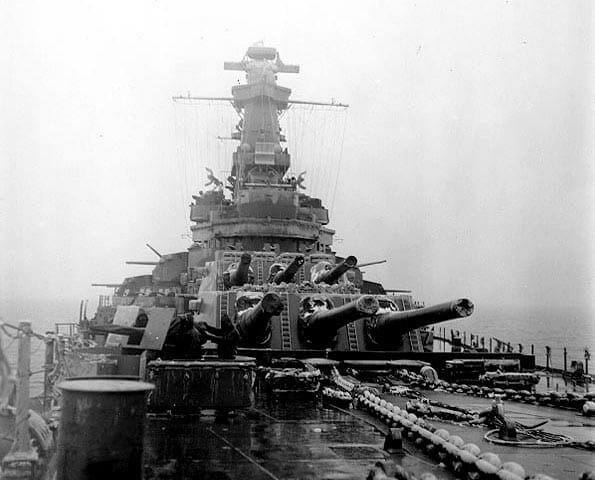 Guns on the USS Alabama (BB-60)
In fall 1944, the Alabama saw heavy action at Okinawa, Luzon, and Surigao Strait during the larger Battle of Leyte Gulf and specifically the Battle of Cape Engaño, during the liberation of the Philippines as a member of Task Force 38. Operating as part of the “Enterprise screen,” the ship stood against the Japanese Southern Force off Surigao Strait, later moving north to challenge the enemy’s Central Force, but saw no ship-to-ship action. In December 1944, the Alabama encountered a fierce typhoon that sank three American destroyers and caused the ship to roll in excess of 30 degrees. That Christmas Eve in Ulithi, Captain Murphy announced that after two years at sea, the Alabama would be heading stateside for much-needed repairs at Puget Sound Shipyard at Bremerton, Washington. The Alabama made a stopover at Pearl Harbor, Hawaii, where Capt. William B. Goggins took command, serving until November 1945.
Guns on the USS Alabama (BB-60)
In fall 1944, the Alabama saw heavy action at Okinawa, Luzon, and Surigao Strait during the larger Battle of Leyte Gulf and specifically the Battle of Cape Engaño, during the liberation of the Philippines as a member of Task Force 38. Operating as part of the “Enterprise screen,” the ship stood against the Japanese Southern Force off Surigao Strait, later moving north to challenge the enemy’s Central Force, but saw no ship-to-ship action. In December 1944, the Alabama encountered a fierce typhoon that sank three American destroyers and caused the ship to roll in excess of 30 degrees. That Christmas Eve in Ulithi, Captain Murphy announced that after two years at sea, the Alabama would be heading stateside for much-needed repairs at Puget Sound Shipyard at Bremerton, Washington. The Alabama made a stopover at Pearl Harbor, Hawaii, where Capt. William B. Goggins took command, serving until November 1945.
Sailing for Pearl Harbor on April 4th after repairs were made, the Alabama was by the end of May offshore of Okinawa, earning a Battle Star for adding protective firepower support for U.S. landing forces. Later, the Alabama was called upon to shell the home islands of Japan. Scoring heavy damage against Tokyo’s industrial regions, the ship earned another Battle Star.
After the Japanese surrender on August 15, 1945, Marines from Alabama‘s detachment landed in Japan as a major part of the occupation force while the ship continued coastal patrol duties. The ship led the U.S. fleet into Tokyo Bay the day after the formal surrender documents were signed on September 2, 1945. During the war, the Alabama voyaged 218,000 miles, shot down 22 enemy aircraft, and earned nine Battle Stars for participating in significant action. Sailing for home on September 20, the “Mighty A” stopped at Okinawa to load 350 sailors and then steamed for California. After voyages to other West Coast ports, the Alabama sailed to Bremerton, where it was decommissioned on January 9, 1947. Captain E. H. Pierce was the ship’s final commanding officer.
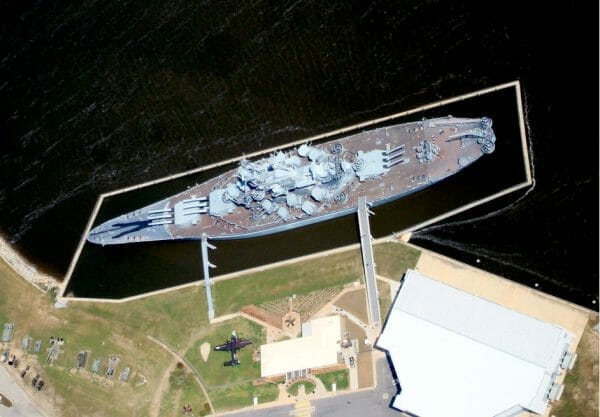 USS Alabama Battleship Park, Aerial View
In spring 1962, the U.S. Navy announced plans to scrap the famed vessel. Citizens of Alabama responded by asking for and receiving permission to berth BB-60 in Mobile Bay as a permanent home to honor and remember all Alabamians who had died in defense of the United States. A document of transfer between the state, represented by the USS Alabama Battleship Commission, and the U.S. Navy was signed on June 16, 1964, with the state taking control on July 7, 1964. It took almost three months to tow the 35,000-ton dreadnought from Bremerton down the West Coast toward Alabama. The 108-foot wide ship was eased through the Panama Canal with 11 inches of clearance on either side. Arriving in Mobile to a hero’s welcome on September 14th, the Alabama was moved into the newly created USS Alabama Battleship Memorial Park and opened to public tours on January 9, 1965. The ship underwent extensive hull renovations in the early 2000s at the expense of $15 million and was damaged in Hurricane Katrina in 2005 but was repaired and reopened for tours in early 2006.
USS Alabama Battleship Park, Aerial View
In spring 1962, the U.S. Navy announced plans to scrap the famed vessel. Citizens of Alabama responded by asking for and receiving permission to berth BB-60 in Mobile Bay as a permanent home to honor and remember all Alabamians who had died in defense of the United States. A document of transfer between the state, represented by the USS Alabama Battleship Commission, and the U.S. Navy was signed on June 16, 1964, with the state taking control on July 7, 1964. It took almost three months to tow the 35,000-ton dreadnought from Bremerton down the West Coast toward Alabama. The 108-foot wide ship was eased through the Panama Canal with 11 inches of clearance on either side. Arriving in Mobile to a hero’s welcome on September 14th, the Alabama was moved into the newly created USS Alabama Battleship Memorial Park and opened to public tours on January 9, 1965. The ship underwent extensive hull renovations in the early 2000s at the expense of $15 million and was damaged in Hurricane Katrina in 2005 but was repaired and reopened for tours in early 2006.
Further Reading
- Garzke, William H., and Robert O. Dulin. Battleships: United States Battleships, 1935-1992. Annapolis, Md.: Naval Insitute Press, 1995.
